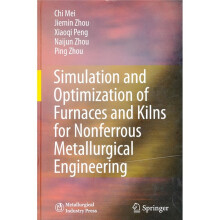1 Introduction
1.1 Classification of the Fumaces and Kilns for Nonferrous Metallurgical Engineering (FKNME)
1.2 The Thermophysical Processes and Thermal Systems of the FKNME
1.3 A Review of the Methodologies for Designs and Investigations of FKNME
1.3.1 Methodologies for design and investigation of FKNME
1.3.2 The characteristics of the MHSO method
1.4 Models and Modeling for the FKNME
1.4.1 Models for the modem FKNME
1.4.2 The modeling process
References
2 Modeling of the Thermophysical Processes in FKNME
2.1 Modeling of the Fluid Flow in the FKNME
2.1.1 Introduction
2.1.2 The Reynolds-averaging and the Favre-averaging methods
2.1.3 Turbulence models
2.1.4 Low Reynolds number k-e models
2.1.5 Re-Normalization Group (RNG) k-e models
2.1.6 Reynolds stresses model(RSM)
2.2 The Modeling of the Heat Transfer in FKNME
2.2.1 Characteristics of heat transfer inside furnaces
2.2.2 Zone method
2.2.3 Monte Carlo method
2.2.4 Discrete transfer radiation model
2.3 The Simulation of Combustion and Concentration Field
2.3.1 Basic equations of fluid dynamics including chemical reactions
2.3.2 Gaseous combustion models
2.3.3 Droplet and particle combustion models
2.3.4 NOx models
2.4 Simulation of Magnetic Field
2.4.1 Physical models
2.4.2 Mathematical model of current field
2.4.3 Mathematical models of magnetic field in conductive elements..
2.4.4 Magnetic field models of ferromagnetic elements
2.4.5 Three-dimensional mathematical model of magnetic field
2.5 Simulation on Melt Flow and Velocity Distribution in Smelting Furnaces
2.5.1 Mathematical model for the melt flow in smelting furnace
2.5.2 Electromagnetic flow
2.5.3 The melt motion resulting from jet-flow
References
3 Hologram Simulation of the FKNME
3.1 Concept and Characteristics of Hologram Simulation
3.2 Mathematical Models of Hologram Simulation
3.3 Applying Hologram Simulation to Multi-field Coupling
3.3.1 Classification of multi-field coupling
3.3.2 An example of intra-phase three-field coupling
3.3.3 An example of four-field coupling
3.4 Solutions of Hologram Simulation Models
References
4 Thermal Engineering Processes Simulation Based on Artificial Intelligence
4.1 Characteristics of Thermal Engineering Processes in Nonferrous Metallurgical Furnaces
4.2 Introduction to Artificial Intelligence Methods
4.2.1 Expert system
4.2.2 Fuzzy simulation
4.2.3 Artificial neural network
4.3 Modeling Based on Intelligent Fuzzy Analysis
4.3.1 Intelligent fuzzy self-adaptive modeling of multi-variable system
4.3.2 Example: fuzzy adaptive decision-making model for nickel matte smelting process in submerged arc furnace
4.4 Modeling Based on Fuzzy Neural Network Analysis
4.4.1 Fuzzy neural network adaptive modeling methods of multi-variable system
4.4.2 Example: fuzzy neural network adaptive decision-making model for production process in slag cleaning furnace
References
5 Hologram Simulation of Aluminum Reduction Cells
5.1 Introduction
5.2 Computation and Analysis of the Electric Field and Magnetic Field
5.2.1 Computation model of electric current in the bus bar
5.2.2 Computational model of electric current in the anode
5.2.3 Computation and analysis of electric field in the melt
5.2.4 Computation and analysis of electric field in the cathode
5.2.5 Computation and analysis of the magnetic field
5.3 Computation and Analysis of the Melt Flow Field
5.3.1 Electromagnetic force in the melt
5.3.2 Analysis of the molten aluminum movement
5.3.3 Analysis of the electrolyte movement
5.3.4 Computation of the melt velocity field
5.4 Analysis of Thermal Field in Aluminum Reduction Cells
5.4.1 Control equations and boundary conditions
5.4.2 Calculation methods
5.5 Dynamic Simulation for Aluminum Reduction Cells
5.5.1 Factors influencing operation conditions and principle of the dynamic simulation
5.5.2 Models and algorithm
5.5.3 Technical scheme of the dynamic simulation and function of the software system
5.6 Model of Current Efficiency of Aluminum Reduction Cells
5.6.1 Factors influencing current efficiency and its measurements
5.6.2 Models of the current efficiency
References
6 Simulation and Optimization of Electric Smelting Furnace
6.1 Introduction
6.2 Sintering Process Model of Self-baking Electrode in Electric Smelting Furnace
6.2.1 Electric and thermal analytical model of the electrode
6.2.2 Simulation software
6.2.3 Analysis of the computational result and the baking process
6.2.4 Optimization of self-baking electrode configuration and operation regime
6.3 Modeling of Bath Flow in Electric Smelting Furnace
6.3.1 Mathematical model for velocity field of bath
6.3.2 The forces acting on molten slag
6.3.3 Solution algorithms and characters
6.4 Heat Transfer in the Molten Pool and Temperature Field Model of the Electric Smelting Furnace
6.4.1 Mathematical model of the temperature field in the molten pool
6.4.2 Simulation software
6.4.3 Calculation results and verification
6.4.4 Evaluation and optimization of the furnace design and operation
References
7 Coupling Simulation of Four-field in Flame Furnaee
7.1 Introduction
7.2 Simulation and Optimization of Combustion Chamber of Tower-Type Zinc Distillation Furnace
7.2.1 Physical model
7.2.2 Mathematical model
7.2.3 Boundary conditions
7.2.4 Simulation of the combustion chamber prior to structure optimization
7.2.5 Structure simulation and optimization of combustion chamber
7.3 Four-field Coupling Simulation and Intensification of Smelting in Reaction Shaft of Flash Furnace
7.3.1 Mechanism of flash smelting processparticle fluctuating collision model
7.3.2 Physicalmodel
7.3.3 Mathematical model——coupling computation of particle and gas phases
7.3.4 Simulation results and discussion
7.3.5 Enhancement of smelting intensity in flash furnace
References
8 Modeling of Dilute and Dense Phase in Generalized Fluidization
8.1 Introduction
8.2 Particle Size Distribution Models
8.2.1 Normal distribution model
8.2.2 Logarithmic probability distribution model
8.2.3 Weibull probability distribution function
……
9 Maultiple Modeling of Single-ended Radiant Tubes
10 Multi-objective Sytematic Optimization of FKNME
Index

 缺书网
缺书网 扫码进群
扫码进群






